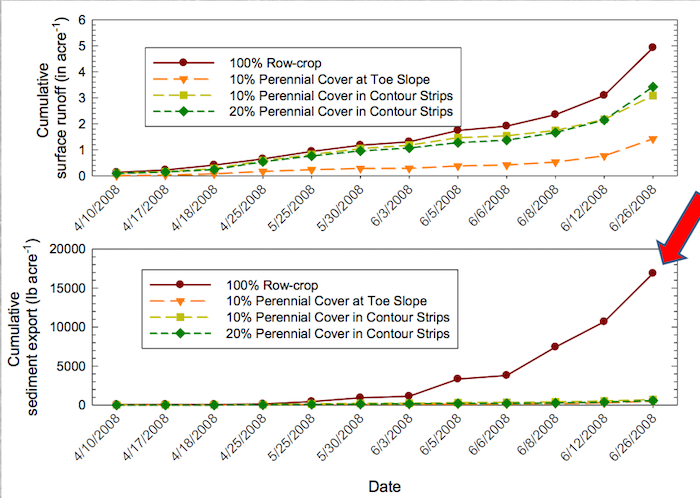If you want to keep soil in place, you’re not going to do it by only growing corn and soybeans — no matter how many conservation practices you use, says Rick Cruse in a recently published article by the Leopold Center for Sustainable Agriculture.
In a webinar recorded last year, the Iowa State University agronomist and director of the Iowa Water Center shared a study that looked at cumulative sediment export between four treatments in watersheds that were less than 10 acres in size between April 10, 2008 and June 26, 2008.
The different field treatments included: 100% row crop, 10% perennial cover at the toe slope (the gently inclined surface at the base of a steep hill slope), 10% perennial cover in contour strips, and 20% perennial cover in contour strips. Cruse notes that all of the field treatments were no-tilled on the contour.
The study found the ground that didn’t have any perennial cover lost 17,000 pounds of sediment per acre, while the ones that did have perennial cover stayed under 1,000 pounds (Figure 1).
“This is not a push on no-till,” Cruse says. “If it was done with conventional tillage, it’d be much worse. But no-till doesn’t do quite as well as we have been led to believe.”
He explains the reason for this is that soil loss equation models don’t include topsoil lost in ephemeral gullies — channels created in fields after a heavy rainfall — which he estimates account for 30% of topsoil loss.
What can be done about this? Cruse emphasizes that some fields and areas can only be sustainable if perennial crops are included, such as trees, prairie and pasture.
But if that’s not an option, cover crops are probably the next best thing.
Figure 1. Cumulative sediment export in pounds per acre. Credit: Rick Cruse, Iowa State University.

As harvest winds down this fall, consider seeding a cover crop if you haven’t already decided to do so. Terry Taylor, a Geff, Ill., no-tiller, shares his tips for using cover crops for the first time.
1. Do your research.
Taylor recommends finding out what cover crops your neighbors are using and develop a strategy based on what you want to accomplish with cover crops.
2. Choose a cover crop species that has a high probability of success in the area.
At this point in the fall in the Midwest, cereal rye may be a good option because it can be planted later, whereas legumes need an earlier start.
3. Start with just one species, as it will make management easier.
For more information and tips from Taylor, check out the article “Cover Crops: Starting is the First Step.”
What practices are you implementing with no-till to prevent more soil erosion? What tips would you recommend first-time cover crop users follow this fall? Leave your thoughts in the comments below.







Post a comment
Report Abusive Comment